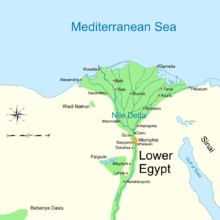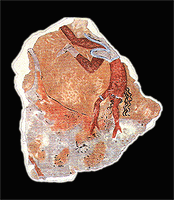Avaris
 Map of ancient Lower Egypt showing Avaris | |
| Location | Sharqia Governorate, Egypt |
|---|---|
| Region | Lower Egypt |
| Coordinates | 30°47′14.7″N 31°49′16.9″E / 30.787417°N 31.821361°E |
| Type | Settlement |

Avaris (Egyptian: ḥw.t wꜥr.t, sometimes hut-waret; Ancient Greek: Αὔαρις, romanized: Auaris; Greek: Άβαρις, romanized: Avaris; Egyptian Arabic: اڤاريس, romanized: Avaris)[5] was the Hyksos capital of Egypt located at the modern site of Tell el-Dab'a in the northeastern region of the Nile Delta.[6] As the main course of the Nile migrated eastward, its position at the hub of Egypt's delta emporia made it a major capital suitable for trade.[7] It was occupied from about the 18th century BC until its capture by Ahmose I.
Etymology
[edit]The name in the Egyptian language of the 2nd millennium BC was probably pronounced *Ḥaʔət-Waʕrəʔ “House of the Region” and denotes the capital of an administrative division of the land (wʕr.t). Today, the name Hawara survives, referring to the site at the entrance to Faiyum. Alternatively, Clement of Alexandria referred to the name of this city as "Athyria".[8]
Excavations
[edit]
In 1885, the Swiss Édouard Naville started the first excavations in the area around Tell-el-Daba. Between 1941 and 1942, Labib Habachi, an Egyptian Egyptologist first forwarded the idea that the site could be identified with Avaris. Between 1966 and 1969 and since 1975, the site has been excavated by the Austrian Archaeological Institute.[9] Using radar imaging technology, its scientists could identify in 2010 the outline of the city including streets, houses, a port, and a side arm of the River Nile passing through the city.[10]
The site at Tell el-Dab'a, covering an area of about 2 square kilometers, is in ruins today, but excavations have shown that, at one point, it was a well-developed center of trade with a busy harbour catering to over 300 ships during a trading season.[11] Artifacts excavated at a temple erected in the Hyksos period have produced goods from all over the Aegean world. The temple even has Minoan-like wall paintings that are similar to those found on Crete at the Palace of Knossos. A large mudbrick tomb has also been excavated to the west of the temple, where grave goods, such as copper swords, have been found.
History
[edit]The site was originally founded by Amenemhat I on the eastern branch of the Nile in the Delta.[12] Its close proximity to Asia made it a popular town for Asiatic immigrants, most of whom were culturally Egyptianized, using Egyptian pottery, but also retained many aspects of their own culture, as can be seen from the various Asiatic burials including weapons of Levantine origin. One palatial district appears to have been abandoned as a result of an epidemic during the 13th dynasty.[13]
In the 18th century BC, the Hyksos conquered Lower Egypt and set up Avaris as their capital. Kamose, the last pharaoh of the Seventeenth Dynasty, besieged Avaris but was unable to defeat the Hyksos there. A few decades later, Ahmose I captured Avaris and overran the Hyksos. Canaanite-style artifacts dated to the Tuthmosid or New Kingdom period suggest that a large part of the city's Semitic population remained in residence following its reconquest by the Egyptians.[14]
The pharaohs of the Eighteenth Dynasty set up a capital in Thebes and the palatial complex at Avaris was briefly abandoned, but areas such as the Temple of Seth and G6 region remained continuously occupied.[15] It appears as well, that the site of Avaris had gone through a hiatus, dated after the time of Amenhotep II and until the late 18th dynasty.[16][17]
After Ramesses II constructed the city of Pi-Ramesses roughly 2 km (1.2 mi) to the north, Avaris was superseded by Pi-Ramesses,[18] and thus finally abandoned during the Ramesside period.[19][20] Large portions of the former site of Avaris were used by the inhabitants of Pi-Ramesses as a cemetery and burial ground,[21] and part of it was used as a major navy base,[22] while the "Harbor of Avaris" toponym continued to be used for Avaris' harbor through the Ramesside period.[23][24]
The name "Avaris" is also referred to in Papyrus Sallier I in the late 13th century BC.[25] In addition, the 'Avaris' toponym is also known to Manetho in the 3rd century BC, quoted by Josephus in his Against Apion 1.14.[26]
Urban chronology
[edit]- Stratiagraphic layers M-N
Amenemhet I (12th dynasty) planned a settlement, called Hutwaret located in the 19th Nome, circa 1930 BC. It was a small Egyptian town until about 1830 BC when it began to grow by immigration of Canaanites (Levant Middle Bronze Age IIA) By 1800 BC it was a much larger trade colony under Egyptian control. Over the next 100 years immigration increased the size of the city.[27] Scarabs with the name "Retjenu" have been found in Avaris, also dating to the 12th Dynasty (1991-1802 BCE).[28]
- Stratiagraphic layers G
At about 1780 a temple to Set was built. The Canaanites living at Avaris considered the Egyptian god Set to be the Canaanite god Hadad. Both were weather gods.[27]
- Stratiagraphic layers F
Around 1700 BC a temple district to the Canaanite Asherah and the Egyptian Hathor was built in the eastern part of the city. From 1700 onward, social stratification begins and an elite arise.[27]
- Stratiagraphic layers E
In 1650 the Hyksos arrive and the city grows to 250 ha. It is believed that Avaris was the largest city in the world from 1670 to 1557 BC. A large citadel was built around 1550.[27]
Minoan connection
[edit]
Avaris, along with Tel Kabri in Israel and Alalakh in Syria, also has a record of Minoan civilization, which is otherwise quite rare in the Levant. Manfred Bietak, an Austrian archaeologist and the excavator of Tell Dab'a, has speculated that there was close contact with the rulers of Avaris, and that the large building featuring the frescoes allowed the Minoans to have a ritual life in Egypt. French archaeologist Yves Duhoux proposed the existence of a Minoan 'colony' on an island in the Nile Delta.[29]
See also
[edit]References
[edit]- ^ Candelora, Danielle. "The Hyksos". www.arce.org. American Research Center in Egypt.
- ^ Roy, Jane (2011). The Politics of Trade: Egypt and Lower Nubia in the 4th Millennium BC. BRILL. pp. 291–292. ISBN 978-90-04-19610-0.
- ^ "A head from a statue of an official dating to the 12th or 13th Dynasty (1802–1640 B.C.) sports the mushroom-shaped hairstyle commonly worn by non-Egyptian immigrants from western Asia such as the Hyksos." in "The Rulers of Foreign Lands - Archaeology Magazine". www.archaeology.org.
- ^ Potts, Daniel T. (2012). A Companion to the Archaeology of the Ancient Near East. John Wiley & Sons. p. 841. ISBN 978-1-4443-6077-6.
- ^ Holladay, John S. Jr. (1997) "The Eastern Nile Delta During the Hyksos and Pre-Hyksos Periods: Toward a Systemic/Socioeconomic Understanding", in Eliezer D. Oren (1997). The Hyksos: new historical and archaeological perspectives. University Museum, University of Pennsylvania. pp. 183–252. ISBN 978-0-924171-46-8.
- ^ Baines and Malek "Atlas of Ancient Egypt" p 15 nome list and map, p 167 enlarged map of the delta.
- ^ Michael Grant (2005). The rise of the Greeks. Barnes & Noble Books. ISBN 978-0-7607-7000-9.
- ^ 'And his remarks are to the following effect: Amosis, who lived in the time of the Argive Inachus, overthrew Athyria, as Ptolemy of Mendes [via Manetho] relates in his Chronology.' -- Clement of Alexandria 1.22
- ^ "Tell el-Dab'a - History". Tell el-Dab'a-Homepage. Archived from the original on 26 June 2010. Retrieved 2010-06-21.
- ^ "Ancient Egyptian city located in Nile Delta by radar". BBC News. 2010-06-21.
- ^ Booth, C. (2005). The Hyksos Period in Egypt. Shire. p. 40. ISBN 9780747806387. Retrieved 2016-02-03.
- ^ Aaron A. Burke, "Amorites in the Eastern Nile Delta: The Identity of Asiatics at Avaris during the Early Middle Kingdom", 2019, p. 69-71
- ^ Marc van de Mieroop, "A History of Ancient Egypt", 2021, p. 124-5
- ^ Bietak, Manfred. "The Aftermath of the Hyksos in Avaris." Culture Contacts and the Making of Cultures: Papers in Homage to Itamar Even Zohar, by Rakefet Sela-Sheffy and Gideon Toury, Tel Aviv University- Unit of Culture Research, 2011, pp.19-65.
- ^ Manfred Bietak and Irene Forstner-Muller. "The Topography of New Kingdom Avaris and Per-Ramesses", pp 27-28
- ^ Bietak, Manfred. "Manfred Bietak, "A THUTMOSID PALACE PRECINCT AT PERU-NEFER/TELL EL-Dab'a," in: M. Bietak & S. Prell (Eds.), Palaces in Ancient Egypt and the Ancient Near East vol. I: Egypt, Contributions to the Archaeology of Egypt, Nubia and the Levant V, Vienna 2018, 231-257".
- ^ "The harbour of Tell el-Dabʿa".
- ^ Marc van de Mieroop, "A History of Ancient Egypt", 2021, p. 125.
- ^ Manfred Bietak, The Palatial Precinct at the Nile Branch (Area H)
- ^ Manfred Bietak, Nicola Math, and Vera Müller, “Report on the excavations of a Hyksos Palace of Tell el Dabᶜa/Avaris.” Ägypten und Levante 22/23 (2013): 15-35.
- ^ Manfred Bietak, "Avaris/Tell el-Dab’a", p. 14.
- ^ Manfred Bietak, "From Where Came the Hyksos and Where Did they go". In M. Marée (ed.), The Second Intermediate Period (Thirteenth - Seventeenth Dynasties): Current Research, Future Prospects, OLA 192, Leuven 2010: Peeters, p. 139.
- ^ Manfred Bietak & Constance Van Ruden. "Contact Points: Avaris and Pi-Ramesse", pg 18
- ^ Timothy Pottis, "Beyond the Nile: Egypt and the Classical World", p. 20
- ^ James Pritchard, ANET, p. 231.
- ^ Manfred Bietak. "Hyksos" in The Encyclopedia of Ancient History, First Edition. Edited by Roger S. Bagnall, Kai Brodersen, Craige B. Champion, Andrew Erskine, and Sabine, p. 3356.
- ^ a b c d Bietak, M. "Tell-el-Daba - History". Tell el-Dabca. Retrieved 30 November 2019.
- ^ Martin, Geoffrey T. (1998). "The Toponym Retjenu on a Scarab from Tell el-Dabʿa". Ägypten und Levante / Egypt and the Levant. 8: 109–112. ISSN 1015-5104. JSTOR 23786957.
- ^ Duhoux, Yves (2003). Des minoens en Egypte? "Keftiou" et "les îles au milieu du Grand vert". Liège: Univ. Press. ISBN 90-429-1261-8.
Bibliography
[edit]- Carl Nicholas Reeves (2000). Ancient Egypt: the great discoveries : a year-by-year chronicle. Thames & Hudson. ISBN 978-0-500-05105-4.
- Manfred Bietak (1996). Avaris, the capital of the Hyksos: recent excavations at Tell el-Dabʻa. British Museum Press for the Trustees of the British Museum. ISBN 978-0-7141-0968-8.
- Bietak, Manfred (2022). "Avaris/Tell el-Dab'a". In Bagnall, Roger S.; et al. (eds.). The Encyclopedia of Ancient History. John Wiley & Sons. pp. 1–16. doi:10.1002/9781444338386.wbeah15052.pub2. ISBN 9781405179355.
External links
[edit]- Tell el-Dabʿa Homepage - available in German and English
- Avaris
- 18th-century BC establishments in Egypt
- Populated places established in the 2nd millennium BC
- Populated places disestablished in the 2nd millennium BC
- Cities in ancient Egypt
- Hyksos cities in ancient Egypt
- Archaeological sites in Egypt
- Former populated places in Egypt
- Nile Delta
- Minoan archaeology
- Tells (archaeology)
- 1885 archaeological discoveries
- Former capitals of Egypt
- Amenemhat I

